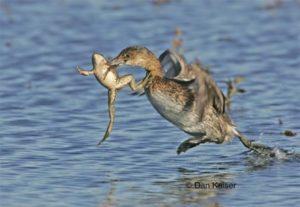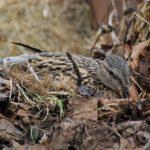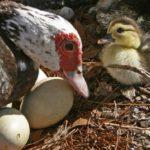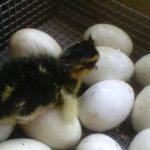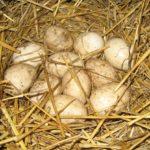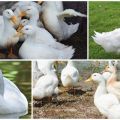How many days does a wild duck hatch eggs and in which nests it lays
Poultry farming on a farm or personal subsidiary farm sometimes begins with the appearance of a wild duck, which the owners bring from their natural habitats. Adapting a bird to new conditions is troublesome, but if it is possible to breed offspring in captivity, the ducklings will feel great in the poultry yard. This raises questions about how many days different species of wild ducks hatch their eggs, how nesting takes place and how many ducklings can be expected.
Where do wild ducks nest?
In natural conditions, wild ducks build nests in secluded places near a reservoir, less often - at a distance from it. It can be shrubs, reed thickets, hummocks, dead wood, abandoned hollows. The responsibilities for arranging the nest, as well as incubating ducklings, fall on the females, drakes usually do not participate in the process.
The most common wild mallard in Russia often nests on the lower tier. The nest looks like a flat depression in grass or soil. The female evens out the deepening made by the beak by the breast, moving in a circle. The wild duck gogol for nesting chooses abandoned hollows, which can be located at a height of up to 15 meters. The nest of a wild sheath can be located several kilometers from a reservoir on the ground or underground, in an abandoned burrow.
Wild ducks build their nests from materials that can be found nearby - dry grass, thin branches. The sides are formed from fluff plucked from the chest, the amount of which increases with the number of eggs in the clutch. Down is used to preserve heat; the female also lines the bottom with it and covers the clutch when she leaves the nest.
In artificial conditions, it is necessary to give the duck a separate corner, fencing off the brood hen from other birds. For arranging the nest, a low basket, a tight box, a small wooden box measuring 40 by 50 centimeters with sides 10 centimeters high is suitable. Hay, straw or sawdust is placed on the bottom.
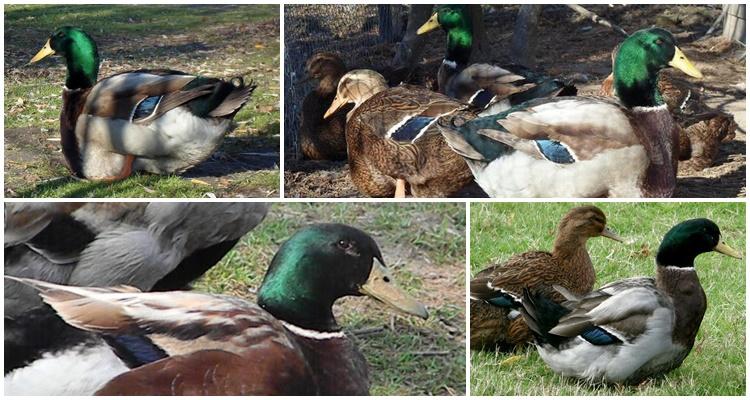
Next to the nest, they place food and water, a bath or a spacious basin of water for bathing. The water needs to be changed regularly to keep it clean. This is necessary to keep the female clean and hatch healthy offspring.
How many days do eggs hatch?
In nature, wild ducks begin laying eggs in April or May. The female lays 1 egg every day, and hatching begins from the day the latter is laid.
The exact period of incubation of chicks, in addition to the species of the bird, also depends on environmental conditions (temperature, humidity, length of daylight hours). At first, ducks leave the clutch to eat and swim twice a day. At the final stage of incubation, females try not to leave the nest.
How many ducklings do they breed in nature?
The number of eggs in a duck's clutch depends on its species, as well as the area of its habitat. In the southern latitudes, under favorable conditions, clutches are usually more than in the northern ones. Clutches of wild ducks of various types:
| Wild duck species | Number of eggs in a clutch | Egg appearance | Average hatching period, days |
| Mallard | 9-13 | Eggs of regular shape, white with a slight light olive tint that disappears as the clutch hatches | 26-28 |
| Gogol | 5-13 | Eggs are oval in dark green or bluish green hue | 29-30 |
| Peganka | 3-12 | Eggs are of the correct oval shape, the shell is shiny, white or ocher | 29-31 |
On average, wild ducks lay 8-10 eggs. The clutch can double if 2 females apply for one nest. In this case, the offspring of both ducks are doomed - the clutch remains abandoned. A duck may lay eggs in a ruined nest, but they will not be fertilized.
Ducklings hatch together during the day, regardless of the date of laying of each egg. After 12-15 hours, the brood already leaves the nest. Ducklings see well, move on land, swim and dive on their own. At first, the chicks try not to go far from the mother, gather under the wings of the female every 2 hours.
Shelf drake, unlike other types of ducks, is involved in raising chicks. Sometimes several broods of Shellings will join and move together. Mallard duck, on the contrary, do not accept contact with other broods - their chicks and females recognize each other well and keep apart.
When do ducklings start flying?
Duck offspring grow and develop rapidly. As soon as real feathers began to appear on all sides of the ducklings instead of the edge, they make their first attempts to take off. Mallard chicks begin to fly above the surface 50 days after they hatch from the eggs, and after 7-10 days from the first attempts, they fully stand on the wing. The offspring of the wild duck gogol begins to fly at about the same time frame - 57-66 days, and the shelled ducklings start to fly earlier - in the period from 45 to 50 days.
